 |
Earth expanded to three continents, Asia, Europe and Africa, (Libya). From Phoenician sailors’ accounts, Herodotus declared that Africa is washed on all sides by the sea, except where it is joined to Asia. "The World of Herodotus, 465 b.C."
In the VI century b.C. another Mediterranean People makes its appearance the Carthaginians. Antiquity Semitic people of Phoenician origin also called Punic People (name given by the Romans). According to the traditional story, are called by the Phoenicians due to Tartessian pressure: They occupied Cadiz destroying that area, Tartessos. Settled a colony in Carthage at the North of the actual Tunisia, as a result of the Phoenician trade movements, in 814 b.C. so the descendants of the Phoenicians of Tyre became the Carthaginians, retaining the original basic characters: language, religion, economy, etc. |
 |
In the first phase of its establishment the Carthaginian territory includes only the city of Carthage and a small area to its round, estimated at about fifty km². In VI century b.C. a greater surface was occupied, between thirty and fifty thousand km² territory, which constituted the base of the Carthaginian State. On this basis, that can be called metropolitan, between the V-III century b.C. Cartaghe created a maritime colonial empire, taking advantage of existing cities founded by the Phoenicians or establishing new ones in; Sicily, Sardinia, Ibiza, South of the Iberian peninsula and North Africa, these ones to the Western Carthage. |
Carthage become the greatest economic and military power in the Western Mediterranean but they clashed with Rome in the struggle for the hegemony of this space, being finally defeated in 146 b.C., which triggered the destruction of the Carthaginian State and the city of Carthage. |
Some history steps sighted from their protagonists' outlook. |
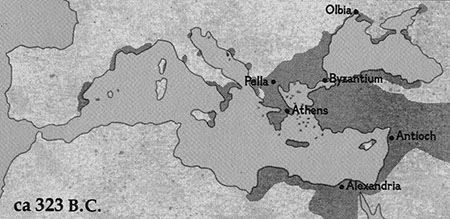 |
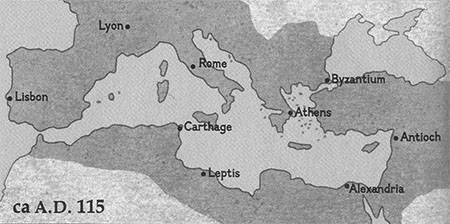 |
Greeks World Map 323 b.C. In the eighth century b.C. Greeks colonized southern Italy and Sicily. Around 600 b.C. Greek City-States began competing with Phoenicians and later fender off Persian invaders from east. Alexander the Great united the fractious cities; his empire eventually extended to India. Rome swallowed Alexander's Hellenistic kingdoms in the second and first centuries b.C. ca (circa) |
Rome World Map a.D. 115. Beginning with the conquest of Italy in the third century b.C. Rome's military overwhelming force defeated both Greeks and Carthaginians, while building an empire from Africa and Asia to distant outpost in Britain. Waves of Germanic invaders ended Rome's heyday in the fifth century a.D., and Mediterranean power shifted east to Byzantium. |
 |
 |
Old Byzantium World a.D. 565. the new Constantinople rose as a center of Christianity in a.D. 330. Strong Greek roots eventually suplanted Latin influences. Emperor Justinian spread Byzantine rule briefly to Spain and Africa before their conquest by Muslim powers. Crusaders, Byzantines and Muslims collided in the Holy Land in the 11th century. |
Islamic World a.D 750 - 1500. whirlwind of faith after a.D. 622 blew the world of Muhammad across North Africa to Spain and into France. Innovations of Muslim craftsmen left their mark on European arts. In time Christians regained control in the west, while Seljuk Turks resisted waves of crusaders in Asia Minor and took Constantinople in 1453, toppling the Byzantine Empire. |
Nebuchadnezzar II conquers the Phoenician territories, so at this moment Malaga is being dominated by the Carthaginians over the year 573 b.C. He wanted to hold on to the Phoenician trade. In the centuries ranging from end of VI b.C to the change of era, Malaga territories are occupied by two types of People: those who lived in the coast, named as Libyan Phoenician and the Iberian native People or Turdetani of the interior. Nebuchadnezzar II was a Chaldean king of the Neo-Babylonian Empire, who reigned circa 605 b.C – 562 b.C. The construction of the Hanging Gardens of Babylon and the destruction of Jerusalem's temple, both are ascribed to him. He is featured in the Book of Daniel and is mentioned in several other books of the Bible. |
 |
Society and Economy. The immigrant population was predominantly Phoenician, mainly from Tyre but they joined to other Peoples from the Eastern Mediterranean. The Legend of the Carthage Foundation refers that Queen Dido came with Cypriots. Later on it is known the existence in this area of Greek Populations belonging to both the Magna Greece or to the Greece itself. We must bear in mind that the miscegenation occurred in all major ancient cities as a result e.g. of slavery, with the addition of slaves acquired frequently in distant markets. In the countryside, the main populations were indigenous; Libyans, who were dedicated to agriculture, submitted by the Carthaginians as well as other minor cities, outside the metropolitan area, where also lived natives of the territory. Nonetheless the urban population of the Carthaginian cities seems to have been coherent and the percentage of descendants of the early Phoenician founders was very high. |
 |
Dido according to ancient Greek and Roman sources, was the settler and first queen of Carthage. Dido, desiring to escape Tyre and her followers arrived on the coast of North Africa where Dido asked the Berber king Iarbas for a small bit of land for a temporary refuge until she could continue her journeying, only as much land as could be encompassed by an oxhide. They agreed. Dido cut the oxhide into fine strips so that she had enough to encircle an entire nearby hill, which was therefore afterwards named Byrsa "hide". That would become their new home. Many of the local Berbers joined the settlement and both Berbers and envoys from the nearby Phoenician city of Utica urged the building of a city. Some parts of her life may be true, other parts are myths. She is best known from the story about her in the Aeneid by the Roman poet Virgil. |
Originally existed a monarchical regime among Carthaginians. It is known the existence of kings who headed troops in the wars of Sicily during the 6th century b.C. At the end of this century they belonged to the dynasty of the Magonids, who was dethroned by a social movement similar to that occurred in the same dates in the Greek cities and took place to an aristocracy government Since then and until the end, Carthage was an oligarchic Republic ruled by nobles, under two Suffets. There was also a Council called by modern historians of the hundred and four, by the number of its components. It was formed by judges, independent of political power, elected among the aristocracy, with immovable position. Suffet or Shophet, a Judge in Canaanite language. They were members of the Senate of Carthage similar to Roman Senate but belonging to a closed aristocracy, which could not be accessed except by birth. It was an elective office to which they can submit any member of that class. The suffets also presided over the trials that were about important issues. His authority extends beyond the city of Carthage and they understood not only in civil matters, but also criminals, in some cases even taking charge of the command of armies. In fact there is not much information left about this position, since the Romans set out to destroy everything that reminds Carthage. Thus, e.g., during the first Punic War Suffets ordered the crucifixion to up four generals, who were accused of having taken personal initiatives in war. From half of 3rd century b.C. the Barquidas or Barca family policy tended to establish a Principality, leaning on the popular masses, at the expense of the strength of the aristocrats, inspired this movement by the Hellenistic contemporaries examples, movement that had no further success due to the destruction of the Carthaginian State in 146 b.C. One of tried measures was to propose the suspension of the irremovability of Council Judges; also known as the Hundred and Four, support of the oligarchy. The economic strength of the aristocracy came of navigations and colonial trade and from the 5th century b.C. that expanded the metropolitan area, also in agricultural possessions. These were engaged primarily in vineyards, olive and fruit trees. Also, at the head of the social scale were the priests, about which we have poor information. The urban village was made by craftsmen, among which highlighted the persons engaged to metallurgy, textiles, glass, timber and shipbuilding-related industries. It is ignored, on the other hand, the existence of serious social problems among urban dwellers, resulting basically from the old Phoenician Fund. Perhaps feeling inhabit of an island far from the ancient homeland and in front of foreign populations, it cohered with greater force to the Carthaginians. |
 |
The slaves were numerous, but without real numbers what they represented in relation to the total population. Indigenous peoples (Libyans), subject, occupied as agricultural laborers in the rural properties of the aristocracy. There was also another area around Carthage, dedicated crops of cereals, giving the State a portion of the harvest, usually the tenth, but in certain circumstances it could reach up to 25 or 50% of it. The presence of this indigenous mass worried repeatedly to the Carthaginians. |
Mosaic floor with slaves serving at a banquet, found in Dougga (3rd century AD). Dougga or Thugga (Berber: Dugga) is an ancient Roman city in northern Tunisia.
Major revolts took place in the 396 and the 379 b.C. when the Carthaginian armies were seriously committed in the wars of Sicily. Another great danger to the Carthaginian society constituted it, at certain times, the mercenaries serving in their own army, above all when the famous revolt of the 240 a. C.
 |
Religion. The Carthaginians imported from Tyre their religious beliefs and in the early days differences of nuance to the cities of origin are not known although we lack documentation to the V century b.C. In this first period, the most important divinity must have been Melqart, the Lord of Tyre, whose Temple was sent from Carthage, every year, a special offering for the city. But these traditions fell into disuse during the 6th b.C., and from the next century begin to observe specific peculiarities of Carthage. The main one is that the most revered gods become Tanit Pele Baal, female divinity, and Baal Ammon, male. The majority of the religious inscriptions found in Carthage, from the indicated date until its end, are dedicated to both gods, which have no direct precedent (at least with the same name) in the well-known Phoenician pantheon. Its origin and exact significance is unknown. It is possible that Tanit adopted forms of the ancient Astarte, but, in any case, when it struck the Romanization was assimilated Juno and not Venus, as it would have corresponded to be equivalent of Astarte. In addition, the North African Roman made Baal Ammon Saturn. We do not know Visual representations of both gods, or they are problematic. Tanit appears under a schematic anthropomorphic symbol (the so-called sign of Tanit). Baal Ammon is represented in some few sculptures and reliefs in the form of a male character of a certain age, sitting on a throne between two Sphinxes. Another feature of the Carthaginian religion is to have kept the practice of human sacrifice, already missing since long time in Phoenicia and Phoenician colonial cities. |
Astarte. Is the Phoenician-Canaanite assimilation of a Mesopotamian goddess at that time Sumerian known as Inanna, them Acadians, Assyrians and Babylonians as Ishtar and the Israelites as Ashtaroth. It represented the cult to Mother Nature, life and fertility, as well as the exaltation of love and carnal pleasures. Over time, it also became goddess of war and received bloodthirsty cults of his devotees. It would be represented naked or barely covered with a thin belt, standing on a lion. In Sumerian mythology, Inanna was the goddess of love, war and protector of the city of Uruk. Finally, the spanish woman names of Estrella and Ester comes from here. With the arrival of the Acadians Inanna is syncretized with the goddess Ishtar. Their representation was a bundle of vertical reeds with curved on top. Associated with the planet Venus, is identified with the Greek goddess Aphrodite and the Phoenician Astarte. Among the Acadians was known as Ishtar. According to Sumerian mythology was the daughter of Nannar (Sin in Acadian, the Moon God) and Ningal (the great lady, the Moon) and twin sister of Utu, Acadian Shamash as known. His consort was Dumuzi (demigod and hero of Uruk). Ishtar or Inanna represents the archetype of the goddess mother. |
 |
Human Sacrifices. In Carthage succeeded until the end of the city, although in the last two centuries is observed the tendency to replace the human victims by other animals such as birds or small mammals. Tradition demanded that each family, at least those of high rank, sacrifice the firstborn in his early childhood. After incineration, the ashes placed in a clay urn and deposited in a sanctuary, accompanying him at times of a stone stele with dedicatory inscription or without it. Shrines of this kind in Carthage and in Punic colonies in Sardinia have been excavated, being able to analyze the cremated skeletal remains, which confirmed it is children, with frequencies less than a year. In the layers above, most modern, urns contain predominantly animal bones, the indicated replacement test. At this point I want to focus on this passage; the submission of Abraham to the will of God, central issue for both Judaism and Islam. Sacrifice of Isaac or Sacrifice of Abraham, are the names of a scene from the Old Testament, Genesis 22:3, also used as iconographic theme in painting and sculpture. "Jewish New Year" is commemorated on the feast of Rosh Hashanah in the Hebrew Calendar, and in the Muslim Calendar Eid al Adha ó Aid al-Adha (عيد الأضحى), "Celebration of the Sacrifice" or "Feast of the Lamb". |
Language and Culture. The language of origin, Phoenician, was maintained during all the Carthaginian stage. It is known through epigraphy, which is poor, since most of the inscriptions are religious dedications, in whose text is always repeated the same formulas. It is observed with the Phoenician origin of differential nuances are scarce. We know that they had especially religious literature, as well as historical or practical type, which have been almost completely lost. We are aware of the existence of a Treaty of Agronomy, translated into Latin by the practical interest offered for the Romans, and the Greek translation, possibly abbreviated, the narrative of the voyage of Hannon along the African coasts. We also know that part of libraries existing in Cartago, their destruction was in 146 b.C. joined the Mauritanian Kings, and the documentation was used by King Luba II of Mauritania to compose his works. Arts and Sculpture. The documentation is patchy. It seems that the Semitic tradition of Carthage is not distinguished in fine arts. Sculpture is serving above all religious beliefs; appears as little and mediocre, influenced in the first centuries by Eastern, mostly Egyptian currents, and from the V century b.C. by Hellenism. We know almost everything about the painting, but there are painted stucco applied to architectural elements. The devastation of the city of Carthage and the fact that most of the colonies continued his life in Roman times prevents to have a solid knowledge of architecture. Greco-Roman written tradition tells us that the public monuments were at the height of the prestige and wealth of the country. In the few preserved elements observed, as in sculpture, the existence of a former period more linked to the East with strong Egyptian influence, and another with three centuries in which triumphed imitation of Greek, especially in regards to the decorative elements, but also for plants. Thus, houses carved into a city recently exhumed on Cape Bon are Hellenistic Greek type, with a central courtyard. |
Industrial Arts. The commercial character of the Carthaginian economy boosted the development of the industrial arts and crafts, key for the Exchange with the coastal Indians of the Western Mediterranean as main market. Addressed to such buyers, was particular concern to obtain qualities. We do not find a comparable Goldsmith to its predecessor the Phoenicians, or at least have not preserved parts that could justify a significant valuation. The jewels, usually of gold, are simple. The vitreous paste had an important role for making necklaces and small vessels designed to contain perfumes. The ivory, easy obtainined when elephants lived in North Africa until the very shores of the Strait of Gibraltar. We know well the Carthaginian Potter productions, abundant, strong and with an industrial character, very far in quality as the contemporary Greek. |
Historical Evolution. From its foundation the 814 B.c. and up to the s. 6th b.C., Carthage had not distinguish themselves especially of other Phoenician colonies in the Western Mediterranean, and we know little of their history. However, based on its expansion in the middle of the 5th century b.C. Carthage colony was established in Ibiza. |
 |
The main shock came for the possession of Sicily, of which the Carthaginians dominated the Eastern Mediterranean end and the Greeks, all the rest. The wars were long and bloody, while neither of the two contenders succeeded with results. Mid century VI b.C. until the first Punic War, in which they were definitely expelled by the Romans, the Carthaginians aspired to the domain of the island, finding its main enemy in Syracuse, who captained the Sicilian Greek cities. |
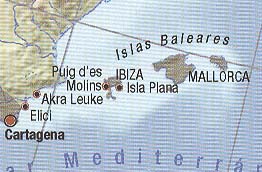 |
The following century, seems to have been the time of transformation, beginning to impose their hegemony over the other Phoenician cities of the West, struggling to halt the Greek expansion, a great danger to their markets. So they counted on, at least in certain periods, with the Alliance of the Etruscans. The fight spread more to the North, and in 535 b.C. they managed to defeat the Phocaeans in the naval battle of Alalia, off the Corsica’s coast. A favorable moment was 480 b.C., when the Greeks, harassed by the Persians in their own metropolitan territory, appeared to be in poor condition for the defense of their territories in the West. But the Carthaginian Persian trial alliance fight against Greeks failed. |
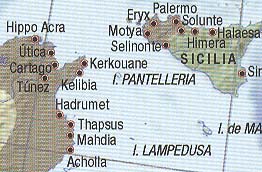 |
Already in century IV b.C the siege of Motya by Dionysius of Syracuse (398 b.C) and after the landing of an army in the Carthaginian territory organized by Agathocles, tyrant of the city seriously undertook the position of the Carthaginians in Sicily. These long struggles forced the Carthaginians to maintain an army far superior to what the limited demographics of the country could give to them. The solution was to enroll a large number of mercenaries, North Africa (Libyan or Berber) and, above all, from the Iberian Peninsula, giving form to what later would be the Carthaginian troops at the time of the Punic Wars. |
 |
Also, the need for cash to pay mercenaries forced to create their own currency, starting with silver coins, imitating Greek Sicilian models, previous to the ones of the own metropolis. More fortunate that in the land war in Sicily were the Carthaginians at sea; since they managed to control the area of the Strait of Gibraltar, closing their Greek rivals. Already in the V century b.C. Since then the Western Mediterranean End was dominated by the Carthaginians until his defeat in the Punic Wars. The Roman intervention outside the Italian peninsula opens a new period of Carthaginian history, they are best known through the classical written sources, not only under the purely military aspect, but also by the main characters. |
However, we are less informed about the history of this phase in regards to policy in the city and in its social and economic aspects as a result of that Roman authors recount especially the outside warlike appearance, with few references made for internal political facts. It seems, however, that Barquidas made an attempt of transformation, truncated by the end of the State, tragically sunk in 146 b.C. at the end of the third Punic War. It is not, however, that the destruction of the city and the Carthaginian State represents the total end. |
 |
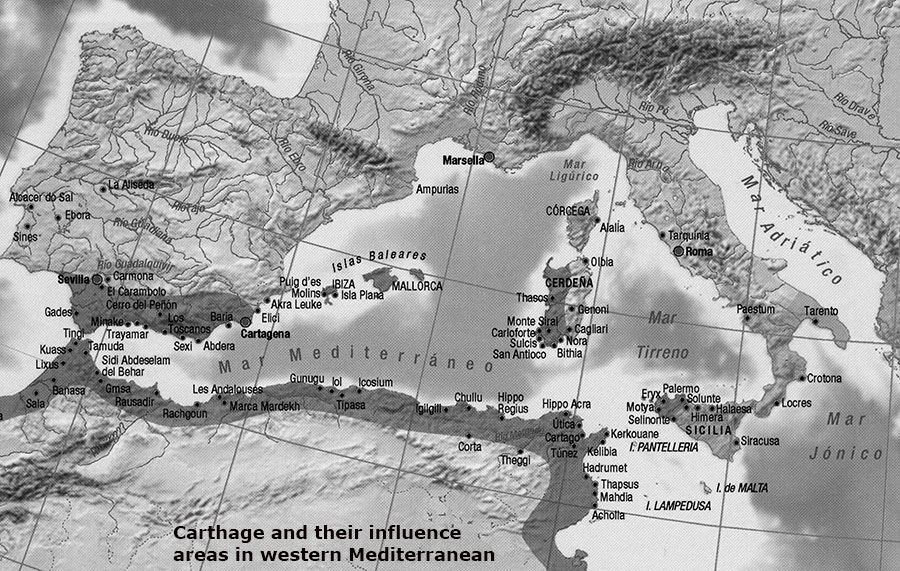 |
An important number of colonial cities continued living under the Roman power, retaining much of the Carthaginian heritage, especially in the early centuries. The phenomenon is visible on the Islands (Sardinia, Ibiza), in the Iberian Peninsula and especially on the coasts of Algeria and Morocco. Even the Phoenician language lingered in the area Carthaginian Metropolitan during the Roman Empire, despite the strength of the Latin, only official and unique language that appears in the inscriptions from the reconstruction of Carthage. Agustín of Hipona refers in his time, century IV a.D. still the Phoenician language was used among the population, and although recently has been proposed that he referred to the Libya language and not to the Carthaginian, most researchers believe that he referred C. |
Travel and Exploration. The navigations of Carthage were not normally beyond the area previously established by the Phoenicians, there is no doubt because just wanted the control of the Strait of Gibraltar area, what amounted to dominate the metalliferous most important sources in the Mediterranean, Tartessos. But we know two Atlantic expeditions, with aim of exploring unknown shores and make new foundations, which were directed by Hannon and Himilcon. The first can be traced through the so-called tour of Hannon, Greek text that translates, in summary form, the original relationship of the trip. It is assumed that took place during the 5th century b.C. and consisted of an expedition organized by the State and directed by Hannon, King of the Carthaginians, probably of the Magonids dynasty. In this expedition were involved 60 vessels of 50 rowers and a large number of passengers. On the basis of taking Gadir (Cadiz), followed the Atlantic coast of Morocco to the South, first establishing colonial foundations, and dedicated the last part of the route to the exploration of unknown shores. Historians commentators have not reached agreement on where was the final limit; for some said the Senegalese coast, for others the coast of Guinea. The points where the colonies were established either can be set exactly given the vagueness of the text (even assumed false). Even without admitting its accuracy, it is a precious document that reflects the existence of expeditions organized by the State, with aim of expanding colonization and open new markets. There is still less data on the Atlantic expeditions from the Strait of Gibraltar to the North, but the classical sources cite a journey of Himilcon, Navigator of contemporary times or some distant from Hannon, who toured the coastline to the North of France and the British Isles. They also developed active exploration by land, through the Sahara desert, to establish trade routes with Africa, Sudan area, producer of gold and exotic materials for the Mediterranean world. Several cities on the coast of the current state of Libya, which during the Roman imperial time supported their wealth on the bases of the desert routes (Leptis Magna, Sabrata, etc.), had been founded by Carthage for the same purpose. There are few historical data about the Carthaginian action across the Sahara, but it is clear that they were from the Mediterranean, the initiators of the exploration of the desert. |
 |
Jesúsf&translation |
